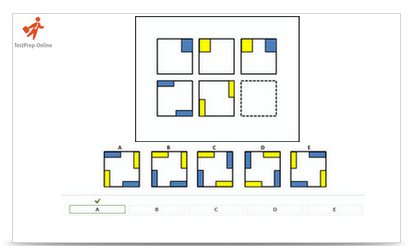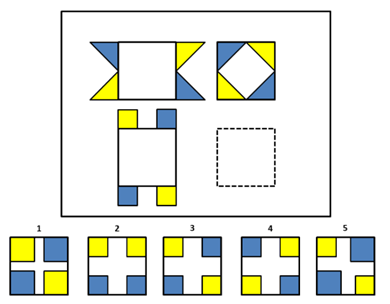- NNAT Spatial Visualization Sample Questions
- How to Solve NNAT Spatial Visualization Questions
- NNAT Video Academy
Spatial Visualization questions require students to mentally manipulate shapes. These items are among the most difficult in the NNAT, especially in questions which involve shapes that intersect in ways which are difficult to recognize or involve rotation.
Spatial Visualization questions are commonly seen on aptitude tests, pre-employment tests, and admission tests to certain academic institutions. NNAT Levels C-G include Spatial Visualization items.
NNAT Spatial Visualization Sample Questions
Below there are two different designs. Determine for each one how the figures relate to each other and apply this relationship to the row with the empty frame. Visualize how the objects might look when rotated, transformed, or combined.
Question 1
Question 2
Answers and Explanations
[1] The correct answer is A.
Look at the top row. The left frame contains a blue square in the top-right corner of the frame. The middle frame contains a yellow square in the top-left corner of the frame. It is possible to deduce that the frame on the right combines both of the figures, as it contains both a blue square in the top-right corner and a yellow square in the top-left corner.
The figures in the bottom row will exhibit the same relationship. The left frame contains two blue rectangles attached to the left and right sides of the top and bottom of the frame. The frame on the right contains two yellow rectangles attached to the top and bottom of the right and left sides of the frame. The empty square will include a combination of the figures in the left and middle frames. Answer choice A adheres to the above requirements and is the correct answer.
This sample questions that demonstrates how Spatial Visualization questions on the NNAT require both shape manipulations and pattern recognition. You, first, had to realize the top row pictures were put together and secondly apply it on the second row.
[2] The correct answer is 3.
Look at the top row and see how the shapes change from the left frame to the right frame. In the left frame, we have a blue triangle on the left side of the frame at the top, a yellow triangle on the left side of the frame at the bottom, a blue triangle on the right side of the frame at the bottom, and a yellow triangle on the right side of the frame at the top. In the right frame they flip into the frame (as if they were attached to the side and were flipped like the flaps of a box).
In the bottom row they should do the same. Therefore, the missing frame should contain a small yellow square in the upper-left and lower-right corners, and a small blue square in the upper-right and lower-left corners.
We can eliminate answer choice 1, because all the squares are too big; and answer choice 5, because the blue squares are too big. We can also eliminate answer choices 2 and 4, because some or all of the squares are the wrong color.
We are left with answer choice 3 as the correct answer.
This questions demonstrates how important color and size are to eliminating answer choices. After realizing the pattern of the top row and eliminating wrong answer choices you already have a good idea on the way the missing part will look like.
How to Solve NNAT Spatial Visualization Questions
- Encourage your child to gesture when s/he encounters difficult Spatial Visualization questions. Studies show that people are more successful at visualizing spatial manipulations when they can use their hands.
- Familiarize your child with common manipulations seen in NNAT Spatial Visualization questions:
- Inward/outward flip
- Shift in position
- Alternating colors
- Combination of shapes (as seen in the example above)
- In questions which contain intricate designs and shapes, it is helpful to focus on one specific part of the design and pay attention to how it is manipulated throughout the question.
- Encourage your child to make it a habit to eliminate incorrect answer choices.
- Research has demonstrated that training is an effective way to improve Spatial Visualization skills. Begin practicing hundreds of Spatial Visualization questions in our practice kits.
NNAT Video Academy
Spatial Visualization questions are particularly difficult, especially in the higher testing levels. The NNAT Video Academy covers these questions in great detail, teaching your child how to strategically approach and solve them. This video series contains five videos which cover each of the four question types that appear on the NNAT in great detail. The video below provides an inside look at the NNAT Video Academy. The Video Academy is included in every NNAT Premium Pack.


To continue with the NNAT Video Academy, purchase any NNAT Premium Pack.
The NNAT and other trademarks are the property of their respective trademark holders. None of the trademark holders are affiliated with TestPrep-Online or this website.

